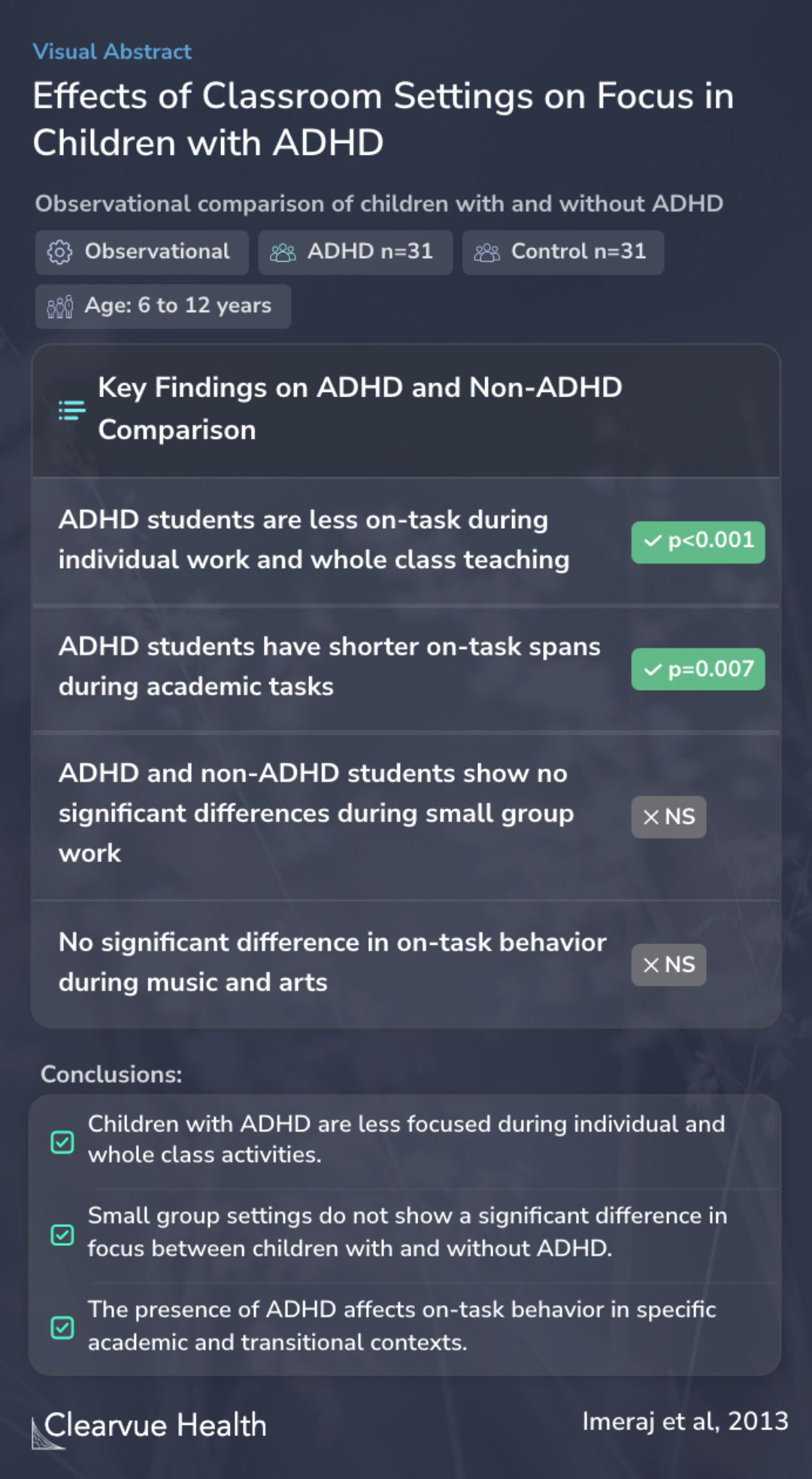The impact of instructional context on classroom on-task behavior: a matched comparison of children with ADHD and non-ADHD classmates
Classroom On-task Behavior in Children with ADHD vs. Non-ADHD
Imeraj L, Antrop I, Sonuga-Barke E, Deboutte D, Deschepper E, Bal S, Roeyers H

Objectives
The study set out to explore how children with ADHD who are not on medication behave in classrooms depending on the type of activity they are doing. This is important because how well these children pay attention in class is closely linked to how well they do in school. The researchers wanted to see if different kinds of classroom activities made any difference to the attention levels of these children.
Classroom inattentiveness is an important reason for clinical referral of children with ADHD and a strong predictor of their educational achievement. This study investigates classroom on-task behavior of Flemish children with ADHD withdrawn from medication as a function of instructional ...
Methods
The researchers looked at 31 pairs of children, each pair made up of one child with ADHD and another child of the same age and sex but without ADHD. They watched these children in their classes over two days to measure how often they were paying attention. They checked if there was any difference when the children were doing different school activities, like working alone or in groups, and when they were learning different subjects. They also noted how much individual attention teachers gave to these children.
Thirty-one pairs of children (one with ADHD and one age- and sex-matched control; 25 boys and 6 girls 6 to 12 years of age) were observed in their classroom environment during two consecutive school days. On-task behavior (time on-task and on-task span) of ADHD and non-ADHD individuals w...
Results
The study found that children with ADHD were often less focused than the other children when they had to work by themselves or when the whole class was learning together. However, they did just as well as the other children during group activities. Also, their ability to stay focused was shorter during lessons like math, language, and science, especially when moving from one task to another. These differences were there even though children with ADHD got more attention from teachers. Interestingly, in music and art classes, both groups of children behaved similarly.
Generalized estimation equation analyses showed that children with ADHD were significantly less on-task than controls during individual work and whole class group teaching, but not during small group work, and had significantly shorter on-task span during academic tasks (mathematics, lan...
Conclusions
The study reveals that kids with ADHD might not pay as much attention as other kids when lessons demand a lot from them, even if teachers watch them more closely.
Findings suggest that despite receiving more overall teacher supervision, children with ADHD displayed lower levels of on-task behavior in settings that place high self-regulatory, information processing, and motivational demands on them. This finding may have initial implications for cl...
Evidence Comparison
The current understanding of ADHD management underscores a spectrum of interventions from behavioral therapies to pharmacological treatments, which align with the study's emphasis on the necessity for differentiated classroom strategies for children with ADHD. The study’s findings are consistent with recommendations such as the use of Parent Training in Behavior Management (PTBM), and school supports like 504 plans and Individualized Education Programs (IEPs). These interventions are critical for addressing the diverse needs of ADHD students in various educational settings, further highlighting the complexity of ADHD management that extends beyond medical treatment to include substantial educational support systems.
Key Takeaways
Context
If you're interested in how different ADHD medications compare in real classroom settings, the study by Biederman et al. might catch your attention. It examines the effectiveness of Lisdexamfetamine Dimesylate and Mixed Amphetamine Salts, providing insights that could influence choices around medication strategies for children with ADHD.
Additionally, the research by Mikami et al. offers a valuable perspective on social inclusion programs in schools. It looks at whether these programs can enhance how kids with ADHD are perceived and accepted by their peers, which could be beneficial for those looking to foster a more inclusive educational environment.